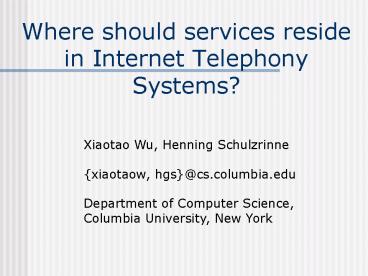Where should services reside in Internet Telephony Systems? - PowerPoint PPT Presentation
1 / 15
Title:
Where should services reside in Internet Telephony Systems?
Description:
Always on (User can have unique address. and can always be reached) Ample computational capacity ... (User's address always changed. and can not be reached ... – PowerPoint PPT presentation
Number of Views:217
Avg rating:3.0/5.0
Title: Where should services reside in Internet Telephony Systems?
1
Where should services reside in Internet
Telephony Systems?
Xiaotao Wu, Henning Schulzrinne xiaotaow,
hgs_at_cs.columbia.edu Department of Computer
Science, Columbia University, New York
2
Outline
- Most services can be in end system
- PSTN vs. Internet Telephony
- Call waiting
- Where should service reside
- End system vs. Network server
- Service architecture
- Programming language model
- DFC
- Service examples for different models
3
PSTN v.s. Internet Telephony
PSTN
Signaling Media
Signaling Media
Internet Telephone
Signaling
Signaling
Media
4
PSTN vs. Internet Telephony
Internet Telephony end system
PSTN
Number of lines or pending calls is virtually
unlimited
More intelligence, PCs can be considered to be
end-user devices
Single line, 12 buttons and hook flash to signal
5
Call waiting
6
Call waiting
Hold on line 1
7
End system v.s. Network server
Network server Permanent IP address Always
on (User can have unique address and can always
be reached) Ample computational capacity High
bandwidth (Conference) Indirect user
interaction Usually only deals with
signaling (Based on predefined mechanisms, or
indirect user interaction, like through web page)
End system Temporary IP address Powered off so
often (Users address always changed and can not
be reached sometime) Limited computational
capacity Low bandwidth (One to one or small size
conf.) Direct user interaction Signal and media
converge (easier to deal with human interaction,
easier to deal with interaction with media)
8
End system vs. Network server
Network server Information hiding Logical call
distribution Gateway
End system Busy handling Call
transfer Distinctive ringing
9
Service architectureProgramming language model
10
Service architectureDFC
11
Call forwarding on busy
c.cgi
12
Call forwarding on busy in end system
Talk on line 1
13
Handle Call Waiting in DFC
LI
LI
CW
LI
14
Handle Call Waiting in DFC
LI
LI
CW
LI
15
Conclusion
- Powerful end systems offer benefits such as
flexibility and personalized services - End system implementation are good for user
interaction - DFC and SIP proxy implementations make it
possible to distribute services - The interaction between end system services and
network services is still an open issue.






























